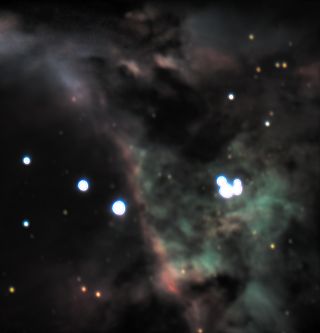Here’s a fresh look at the wonderful Orion Nebula complex (M42 and M43) and the neighboring Running Man. Although I have shown both before, this new view shows how they are related to each other. This is also a longer exposure than before and has been processed to reveal additional subtle detail.
Orion Nebula and Running Man (40 min total exposure Feb 28, 2022)

The Orion Nebula (M42) is an enormous cloud of gas and dust, one of many in our Milky Way galaxy. It lies roughly 1,300 light-years from Earth. At some 30 to 40 light-years in diameter, this great big nebulous cocoon is giving birth to perhaps a thousand stars. But most of the stars in this emerging cluster are hidden behind the nebula itself. M43 is actually a part of M42 but was assigned a separate identifier because in early telescopes it looked like a separate object.
The Nebula is part of a much larger nebula that is known as the Orion Molecular Cloud Complex. The Orion Molecular Cloud Complex extends throughout the constellation of Orion and includes the Horsehead Nebula and the Flame Nebula. Observers have given names to various features in the Orion Nebula. The dark lane that extends from the north toward the bright region is called the “Fish’s Mouth”. The illuminated regions to both sides are called the “Wings”.
The Running Man (sometimes called the Ghost Nebula) vaguely resembles the shape of a man sprinting, with his huge arms in motion. The Running Man nebula comprises three separate reflection nebulae, NGC 1973, NGC 1975, and NGC 1977 that are divided by darker regions that form the man himself.
Reflection nebulae don’t emit light of their own, instead they are made of dust that is lit up by nearby embedded young stars.
I processed the same image more aggressively in order to bring out more subtle details and filaments:
Orion Nebula and Running Man (40 min total exposure Feb 28, 2022)

The four brightest stars at the heart of the Orion Nebula are known as The Trapezium. The light of the young, hot Trapezium stars illuminates the Orion Nebula. The following image is enlarged 4 times the scale of the previous images and has been processed to reveal the trapezium stars instead of having them be washed out by the bright heart of the Orion Nebula.
The four Trapezium stars are known as Theta1 Orionis, and the 3 similarly bright stars to the left of the Trapezium are known as Theta2 Orionis. In a larger telescope two of the Trapezium stars can be resolved into their component binary systems, giving a total of six stars.
Theta2 Orionis and the Trapezium (40 min total exposure Feb 28, 2022)

Click here to see my previous post of the Orion Nebula and click here for my previous post showing the Running Man.